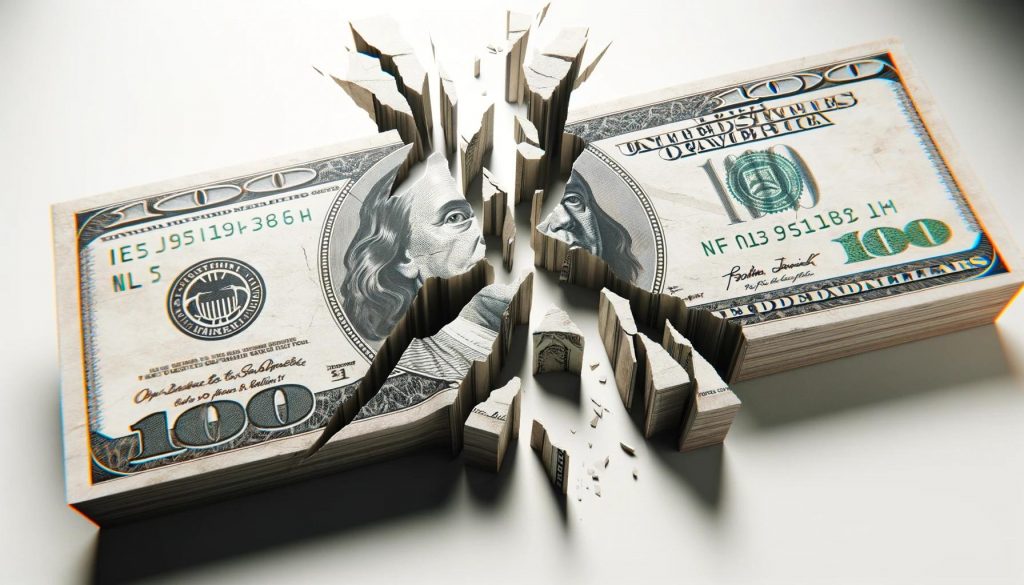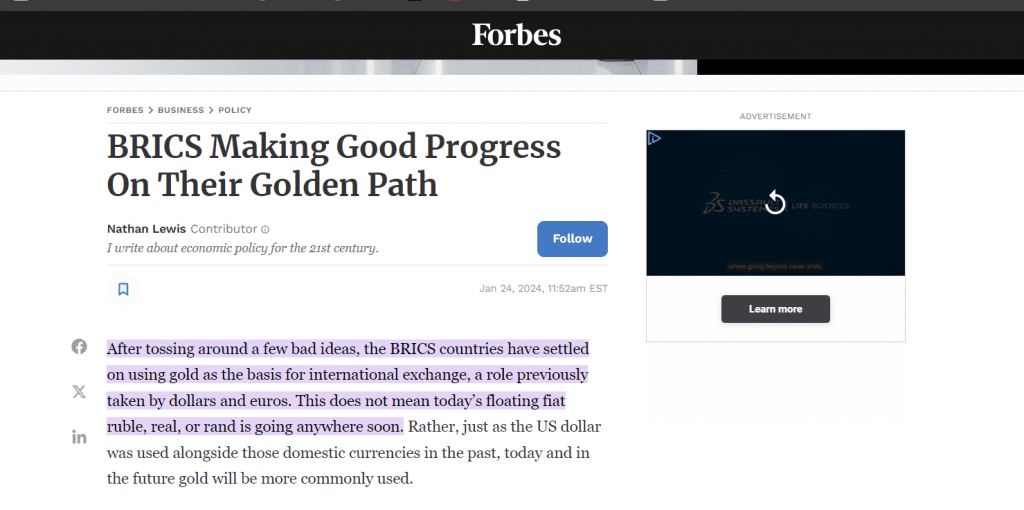What if the world’s most dominant currency, the US dollar, is losing its grip on global power? De-dollarisation is a seismic economic shift that could reshape the global financial landscape as we know it.
Imagine a future where the dollar’s influence wanes and emerging currencies, backed by hard assets rise to prominence. This change will impact everything from inflation and currency valuations to global geopolitical stability. Let’s dive into the mechanics of this transformation and what it means for me and you.
The Rise & Fall Of The Dollar
The US dollar’s journey to becoming the world’s primary reserve currency began after World War II. The Bretton Woods Agreement in 1944 established the dollar, backed by gold at $35 an ounce, as the backbone of the global financial system.
However, the collapse of Bretton Woods in 1971 and the subsequent abandonment of the gold standard led to the era of fiat currencies, money not backed by physical assets but by government decree.
This enabled the US to print money at will to fund growth, innovation and expansion. As more money is printed it’s relative value decreases and an ounce of gold is now worth over $2,200 USD. Gold hasn’t gone up in value as much as the dollar has depreciated relative to all hard assets

We can use the compound annual growth rate (CAGR) to calculate the real rate of inflation per year at 7.54% (method below)
function calculateCAGR(initialValue, finalValue, numberOfYears) {
return Math.pow(finalValue / initialValue, 1 / numberOfYears) - 1;
}
const initialValue = 35;
const finalValue = 2200;
const numberOfYears = 2024 - 1971;
const cagr = calculateCAGR(initialValue, finalValue, numberOfYears);Far above the advertised 2% CPI target but this also lines up with historical stock market growth at approximately 7% a year. The devaluation of the dollar as the government printed and spent more and more funds wasn’t the only issue however.
BRICS and a Shifting Power Balance
For decades, American economic dominance seemed unassailable. Yet, the rise of the BRICS nations (Brazil, Russia, India, China, and South Africa) signals a global power shift from West to East. This coalition represents a significant portion of the world’s population and economic output, challenging the status quo. The United States dominance, like any global superpower from history is unsustainable and now faces formidable contenders.
Dedollarisation involves countries reducing their reliance on the US dollar for international trade and finance. We’ve seen this already as Brics nations engage in bilateral trade agreements, settling transactions in their native currencies.

This move is seen partly a response to the weaponisation of the dollar through sanctions and trade wars, prompting nations to seek financial independence. In my opinion the shift was always going to happen and the US fell into a trap giving BRICS nations justification through it’s agresive financial actions.
BRICS nations are strategically accumulating gold and other commodities, possibly laying the groundwork for a new currency backed by hard assets. Russia has publicly stated its efforts in developing such a currency and recent developments have suggested this will be a gold backed digital currency. A shift towards asset backed currencies could offer greater stability compared to the current fiat system, which is prone to inflation discussed above.
If dedollarisation progresses, its effects will ripple through global markets. Reduced demand for US dollars could lead to higher inflation, which would force the FED to maintain higher interest rates, which would lead to weakening economics and falling asset prices in the United States. This would accelerate the shifting political and economic headwinds.
Institutions like the IMF and World Bank, long reliant on the dollar’s dominance, may need to adapt to a multipolar currency world. Is there potential for a responsive competing digital asset created by western institutions?
“Growing pressure for a new global currency comes after continued weaponisation of the US dollar in the form of sanctions and trade wars. Many countries are seeking greater independence from the US financial system. It’s conceivable to see BRICS nations entirely self-sufficient, trading among themselves without any reliance on the United States. This may well be Chinas plan, given the extent of its Belt and Road Initiative, the largest infrastructure development project in history aiming to connect Asia and Africa, Europe and South America. As the reliance on US dollars diminishes, central banks will begin dumping their dollar reserves. This will result in hyperinflation, a spike in interest rates to compensate for the loss of purchasing power, and falling asset prices, further accelerating US decline.” – Lowy Institute
Central Bank Digital Currencies
Central bank digital currencies (CBDCs) are the future of money despite the recent negative rhetoric coming from political opponents. I’m not suggesting they will be on public blockchains but cash is dead, the benefits of digital assets are clear, we will be using our phones, cards and perhaps biometrics for transactions in the future.
Central governments aren’t going away and they gain a lot of power and control through the minting and monitoring of currency transactions within their state. While many libertarians might like to pay for everything in Bitcoin it’s unlikely that this would ever be allowed and I expect most states to mandate that transactions within their borders are carried out in the government issued digital asset.
Central bank digital currencies could be either inflationary like traditional fiat, or backed by hard assets ensuring stability and a move towards Austrian economics. Any countries that impose asset backed currencies are going to have an advantage in forex markets which could lead to further negative implications for inflating currencies.
Implications of DeDollarisation
While the US dollar isn’t likely to go into a death spiral of hyper inflation any time soon, the US and other western governments wont be able to print money at will and have other countries around the globe value that money forever.
This in turn raises questions about how countries reliant on a money printer can sustain growth long term?
For those living in Western economies, a world where the US isn’t the biggest economy (China likely to overtake in the next decade), dedollarisation may seem distant but will have tangible effects. Inflationary pressures, changing investment landscapes, and shifting geopolitics will influence everyday life.
We are living through a time of shifting economic and political powers, on the cusp of a new world order. Dedollarisation is more than an economic trend hinted at by journalists, it’s a fundamental macro shift happening right now with profound implications. Anticipating these changes means embracing a new reality and preparing for a future where multiple currencies and political powers share the stage.
“Global reserve currencies do not shift around in popularity like shares listed in the Financial Times Stock Exchange or Dow Jones. They occupy critical and pivotal roles in the monetary system, and the role the US dollar plays is unprecedented and for now at least, irreplaceable.” – Council on Geostrategy
If you want to stay up-to-date with blockchain development and emerging DeFi technology, I invite you to join my newsletter at https://bachini.substack.com


